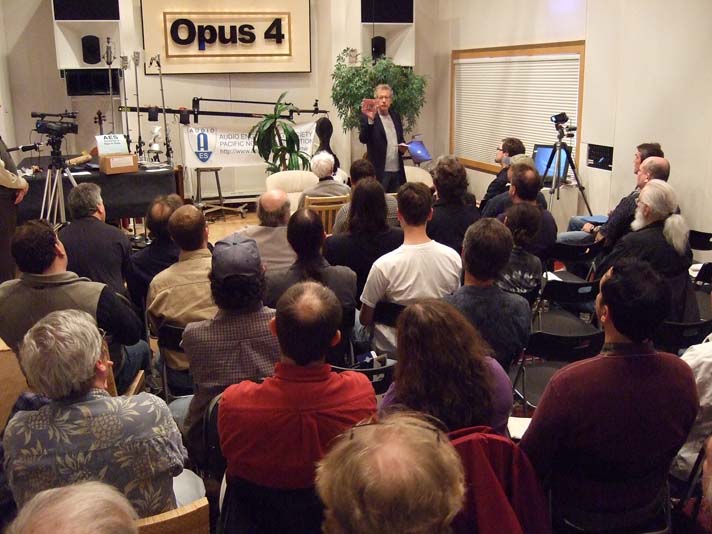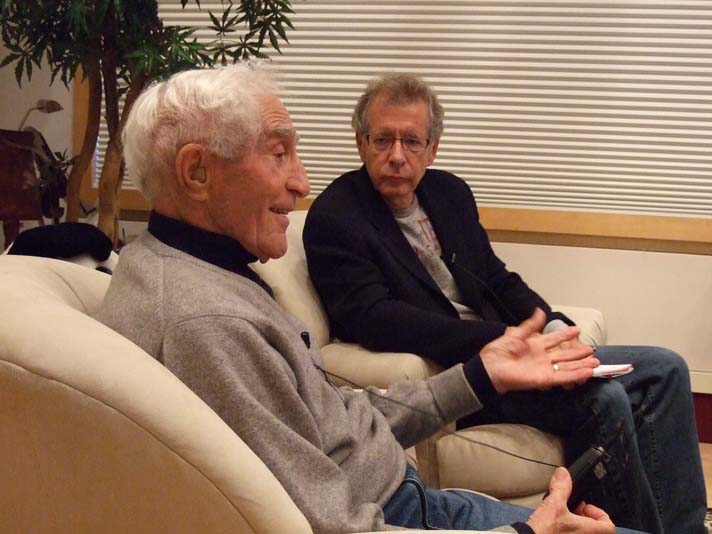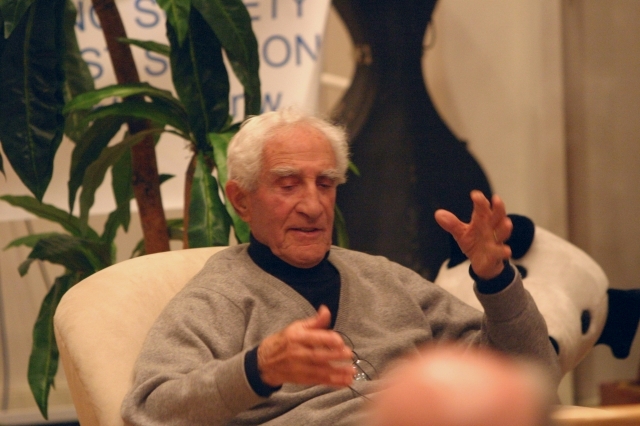

Tom Conrad showing some of Frank's work. |

(L-R) Frank Laico and Tom Conrad |

Frank Laico |
| Photos by Gary Louie and others | ||
| Audio Recordings of the Meeting
part 1 (64k mp3, 30Mb)
|
||
The PNW Section's June guest was retired recording engineer Frank Laico. Frank worked at CBS/Columbia Records in New York between 1947 and 1982 at Liederkranz Hall, and their famed 30th street studio, a repurposed Greek Orthodox church building. His projects included some of the most famous works of artists such as Tony Bennett, Frank Sinatra, Miles Davis, Thelonious Monk, Barbra Streisand, Andy Williams and Johnny Mathis. Frank moved out to the Seattle area 2 years ago. Jazz writer Thomas Conrad (Stereophile, Jazz Times) served as emcee/interviewer for the evening, held at Opus 4 Studios in Bothell, WA. 20 AES members and 17 non-members attended.
PNW Chair Rick Chinn opened the meeting, having attendees briefly introduce themselves. AES President Bob Moses helped run the PNW business meeting/election, and with a quorum counted (20), a voice vote to accept the unopposed 2008-9 slate by acclaimation was accepted. Results: Chair: Steve Turnidge Vice Chair: Rick Chinn Secretary: Gary Louie Treasurer: Dave Franzwa Committee (new 2 year terms): Mark Rogers, Rob Baum, James Johnston (JJ), Ivan Tashev, Kevin Jablonsky
Then, on to the main event. A DVD slideshow was played with photos of Frank at work accompanied by some of the
music he recorded. Much of the material was courtesy of David Simons, author of "Studio Stories," a book
that covers much of Frank's career as well as other's.
Studio Stories-How the Great New York Records Were Made (on Amazon.com)
Opus 4 Studios owner Dr. Mike Matesky introduced Frank and emcee Tom Conrad.
Tom talked about the plans for the evening, noting Frank's Grammy awards (i.e. Tony Bennett/I Left My Heart in San Francisco) and his amazing list of artists. He also noted that here he was again with no shoes (an Opus 4 custom), having recently also interviewed Roy DuNann here for a previous AES meeting. He asked Frank about his early life.
Frank told how he was born and raised in NYC, the middle child of 7. His dad lost his business in the Great Depression, forcing Frank to leave junior high school to help the family by working. He never felt deprived, and the family always had food. He was working as a delivery boy/apprentice butcher when a customer took a liking to him, and asked what he wanted to do for a career. Frank said he wanted to go to the NYC police/fireman school (Delahanty's), but couldn't figure how to swing it. The man said he was treasurer of a recording company (World Broadcasting) and offered him an entry level job, giving Frank a contact name and address. He was hired to be a mimeograph operator. He walked the halls in his free time, listening for music, found wax disc mastering going on and was fascinated. He talked with the engineers, who welcomed him to watch anytime. After a while they let him drop the stylus on the lathes, which he liked and was good at, and he knew he wanted to work there. They said, "ask the boss," who declined at first, then eventually offered Frank a full time $17/week apprenticeship, but he wasn't paid overtime and supper money like the rest of the staff. He complained, and eventually they gave him that. He loved this work, and noted that later, his wife would be very understanding about his enthusiasm for his work.
Conrad asked about learning the recording business, such as it was then, before being drafted in 1943 because of World War II.
Frank said he had to keep asking about taking more responsibilities. He started with single microphone projects. This was recording onto wax platters, then later direct to coated glass, then aluminum discs. He credits some of his success to starting with mono. You had to get the sound, balance, ensemble, - right, with no retakes. Then in 1943, he was drafted. At basic training, he called his sister at home, who asked why the FBI was asking everyone in the neighborhood about him! It seems the Army Signal Corps had taken over some of World Broadcasting for the war effort and needed someone who knew how to cut records. Frank's boss told them that the man they wanted had just been drafted, which resulted in the Army searching for Frank and then assigning him to a secret division that made records that were part of a Top Secret voice scrambling system (SIGSALY). This project was only recently declassified, and he can now tell people what he did.
Tom asked for more about his post-war experiences, when he eventually went to Columbia. How did Frank get started at Columbia?
Frank said that before the war, CBS used World Broadcasting facilities via phone lines for their mastering. A Columbia manager offered Frank a job when the war was over. After the war, he felt obliged to go back to World Broadcasting and asked about the salary for returning - $40/week + OT (his pre-war salary). He declined, bouncing around several jobs, until he finally went to ask at Columbia. This manager said, "Finally! I can tell you every place you've been since you got out of the Army..." He started work in the summer of 1946 at Columbia. He loved the church's acoustics at 30th street so much he turned down higher paying jobs, staying at Columbia 35 years. Great artists worked there, and he became part of the music industry. He did Tony Bennett's audition recording, his first records, and everything else until 1982, when he left CBS. In 1992, Tony asked Frank back to do the "Perfectly Frank" album for him, which reinvigorated his career.
It was time to hear an example of Frank's work at the Columbia 30th street Studio - "Teo" was played for the audience, recorded March 21, 1961 by Frank, with Miles Davis and John Coltrane.
"I haven't heard this in years!" Frank exclaimed. Conrad read some quotes from David Simons' book, "Studio Stories" about the natural echo from the room, and how Mitch Miller lauded Frank's work. How did Frank do his setups?
Frank said that room was a special place, and Mitch Miller was a very famed producer as well as having his funny old TV sing-along show. The room was 100x100x100 feet, with a beautiful natural reverb/echo. Mitch wanted that reverb, and wanted the room left untouched, dirty and funky. Two years before Frank left, after Miller had left Columbia, CBS corporate cleaned the place, and Frank said the sound was totally different. Mitch would stand behind Frank during sessions, smoking Cuban cigars. The lingering smell on Frank woke his wife when he came home. But they worked well together to get the sound that Mitch wanted. When the "Sing Along with Mitch" program was broadcast on NBC TV, Mitch immediately phoned Frank asking what happened to the sound?! The NBC limiters! They convinced NBC to turn off the limiters for Mitch's show.
This interview is great fun, said Frank - he offered to come back again for more!
Conrad took some quotes from Simons' book about how Frank had miked/tracked sections separately, in a time when only a few tracks were available and when classical recording used overhead mic blends.
Frank said he never isolated sections. Artists would play as an ensemble so they could hear themselves, and therefore play more musically. He never listened to separate tracks - he listened to the mix.
Tom quoted engineer Roy Halee (Simon & Garfunkle) who said he was never comfortable in 30th Street, but "Frank Laico had that room in his back pocket." Frank remarked that Halee took so long to do those recordings. He (Frank) could never work that way.
The next musical interlude played was Thelonius Monk, "Green Chimneys" from the reissued "Straight No Chaser" album. Recorded by Frank Laico, Nov. 14, 1966 at the 30th Street Studios.
Conrad noted that 30th Street was an old church Columbia acquired in 1949.
Frank said it didn't look much like a church. That Monk track, no music was written down - no one (musicians or engineer) knew in advance what was going to happen. He got no cues during the performance, he just had to listen and pay attention. "I don't know what the industry is today, but I was in the middle of the best period of music this country had ever heard. And I was so thrilled." he said.
Miles Davis and Thelonious Monk - what were they like? asked Conrad.
According to Frank, neither spoke much. He had many sessions with Monk, with not a word from the musicians or him. Davis spoke a little, and was an imposing guy, without being vocal. Some said he was nasty, which Frank found not to be the case - they respected each other, and became friends. They split when Davis went "electronic" and Frank told Miles he wasn't enjoying this new musical direction.
Tom then asked about some of the vocal albums, and read some Mitch Miller experiences from Simons' book. Mitch and Frank developed the signature Columbia vocal sound, for which they also used echo chambers.
That room (30th St), said Frank, had a great sound of its own, but if you added some vocal echo, it had to fit. He went to visit Les Paul once to ask about his echo techniques (predelay), and Frank started to use this. He didn't like the existing electronic reverb (like EMT). He's also used stairwells & empty rooms for reverb chambers. English engineers came to listen once, marveled at the sound, but Frank didn't tell them about the echo chamber's room specs.
Tom said that Malcolm Addey (a Beatles engineer) was one of those people checking on Frank's echo sound. Never quite got it, he says.
The next musical interlude was Tony Bennett singing "East of the Sun (West of the Moon)." Conrad recalled how he met Bennett once while he was an executive with Magnolia Audio-Video/Best Buy. Would Frank talk about the Bennett "...Heart in San Francisco" session?
Frank remembered it clearly. In those days you recorded four tunes in three hours. Mitch Miller produced, and said to start with San Francisco. Tony comes in, says he doesn't want to do that song. They do another song, then Mitch asks for San Francisco again, and again, Tony says no. After 3 tunes, Mitch gets disgusted, tells Frank to produce San Francisco, and leaves. Frank asks Tony to do the song, they do 3 takes, the 3rd was "the one." Tony didn't much like it then, but now it's probably his favorite.
We listened to the result, Tony Bennett singing, "I Left My Heart in San Francisco."
Frank noted that the session started at 11pm. "San Francisco" was done about 2am. No overdubs, all done live. In those days, they worked on diction!
Tom remarked that Bennet never rerecorded that song until the recent "Duets" album. He asked Frank how the various engineers were chosen on albums in those days. Frank said that the producers usually decided.
Conrad then read a quote from Frank that in 1982, when the 30th St. Studios were torn down, was the saddest time of his life. He quit CBS shortly thereafter.
Frank knew Sony was coming in, and he didn't want to start over. Mitch Miller asked about buying it, but Frank didn't want to run it. It was a pity, it was a landmark, and it sold for peanuts, he lamented. The land was worth more than the building was worth as a studio.
Just before a break, Tom asked for any fond memories from those days.
Frank said he had many. Barbra Streisand came in once, he was not impressed. He set her session up, then was taken in by her voice. They did three sessions, and Streisand and her manager asked Frank what he thought - "I think it's a hit," he said. If it is, you have a new car, they told him. He smiled and said he wished they hadn't said that - he has 4 or 5 cars owed already and they haven't arrived yet (joke). He never got a car.
A refreshment break was then held, and a prize drawing.
Doorprize winners:
Mark Edman CD
Dave Tosti-Lane walkin DVD, pictures courtesy of David Simons.
Andrew Kosobutsky Jellyfish EP CD, courtesy of Steve Turnidge
Ark Litvin Posies EP CD, courtesy of Steve Turnidge
Jayney Wallich Jellyfish CD set, courtesy of Steve Turnidge
Bruce Brown Posies CD Set, courtesy of Steve Turnidge
Mark Rogers Stereo pair of mike cables, courtesy of Rene Jaeger/Loud Technologies
Tom Monaghan Autographed (by Laico) David Simons book, "Studio Stories", courtesy of Bob Smith
Ian Hayles Autographed (by Laico) David Simons book, "Studio Stories", courtesy of Bob Smith
After the break, a Q & A session with Frank was held.
Q - What about your string bass miking technique?
A - Frank worked hard on getting good bass sound, generally miking towards the F hole. He knew the players, and their tone.
EQ was used if needed. He didn't like the small cheap mics taped on the bridge, and wasn't concerned about isolation.
Q- Any stories about Sinatra?
A - In those days, diction was important. Laico was thrilled to work with Sinatra, and enjoyed his music. A gentleman all the way,
they got along fine, both being of Italian descent. Frank did six albums with him, including "New York, New York."
Q - His violin mike technique? How many?
A - On orchestra, with six 1st violins, six 2nd violins, etc, one mike would be used for each whole section, carefully placed and
listened to. Usually it was a Neumann M49 on the strings, unlike others using the U67, which was too sizzly for him. With a chorus, there were not enough mics and channels, so he would move the chorus behind the strings and adjust the string mics as needed to cover everything.
Q - What speaker and mic were in the echo chamber?
A - Frank wasn't sure now, but thought it was the Neumann U67 mike (which he didn't like much) and the speaker likely was an Altec.
You must control the sound level fed into a chanber very carefully for good results.
Q - The piano sound, especially in "San Francisco?
A - You must have a nice piano in the first place. Frank didn't mike too close, either. Piano duo Ferrante & Teicher once asked him to do
an album. They said they had used an engineer before with close miking, so Frank tried his not-so-close mics - F&T liked Frank's method much better.
Q -Who was the pianist on "San Francisco?
A - He didn't recall. Bennett uses Ralph Sharon on piano now. Session guys then were the best. Frank mentioned Dick Hyman and Bucky
Pizzarelli as particularly hard workers, showing up early and rehearsing long hours.
Q - Any big mistakes he recalls?
A - Not really. He loved working at Columbia.
Q - How did he feel about Rock n Roll coming?
A - He didn't understand the appeal. He felt it was a decline of good music, with no diction on the singing.
Q - Did he go to live performances?
A - All the time. Frank said his family was all interested in playing music, although did not end up as professional musicians.
Q - Frank's stereo system at home?
A - He had one, and the family listened to what they liked.
Q - The Columbia Stereo 360 Sound - what was it?
A - It was a surround sound idea, but there was no company support for producing it.
Q - Surround work? quad?
A - Frank felt Columbia was not a leader in those, but a follower. There was no support for doing such recordings right.
Q - Did you do any electronic music?
A - Well, some electric guitars. A few projects had synths done after the live recording.
It was time to call an end - Frank stated he enjoyed the evening very much and wanted to come back! It was a lot of happy memories for him. He seemed none the worse for wear after having brain surgery two weeks prior.
Reported by Gary Louie, PNW Section Secretary